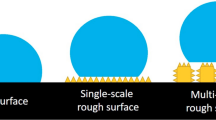Abstract
In this study, two kinds of WC–Co coatings with different decarburization levels were deposited by high-velocity oxy-fuel (HVOF) spraying using the ultrafine WC–Co composite powder and commercial micronsized powder, respectively. The hardness and elastic modulus were measured on the top surface and cross sections of the prepared coatings by the nanoindentation method. The results show that the ultrafine-structured coating has much higher density and inhibited decarburization than the conventional coating, which thus results in higher hardness and elastic modulus values than the micronsized coating. The wear resistance of thermal-sprayed cermet coatings greatly depends on the cross-sectional hardness and elastic modulus which reflects the bond strength between splats to some extent. Based on the analysis, a better understanding of the microstructure and properties in cermet coating materials was obtained.







Similar content being viewed by others
References
Jing QF, Tan YF. Tribological properties of cobalt-based alloy coating with different cobalt contents by electro-spark deposition. Rare Met. 2013;32(1):40.
Liu SL, Zheng XP, Geng GQ. Influence of nano-WC–12Co powder addition in WC–10Co–4Cr AC-HVAF sprayed coatings on wear and erosion behavior. Wear. 2010;269(5–6):362.
Wang HB, Song XY, Liu XM, Wei CB, Gao Y, Fu J. Effect of heat-treatment of spray-dried powder on properties of ultrafine-structured WC–Co coating. Surf Coat Technol. 2012;207:117.
Afzal M, Ajmal M, NusairKhan A, Hussain A, Akhter R. Surface modification of air plasma spraying WC–12% Co cermet coating by laser melting technique. Optics Laser Technol. 2014;56:202.
Shipway PH, Gupta K. The potential of WC–Co hardmetals and HVOF sprayed coatings to combat water-droplet erosion. Wear. 2011;271(9–10):1418.
Mateen A, Saha GC, Khan TI, Khalid FA. Tribological behaviour of HVOF sprayed near-nanostructured and microstructured WC–17 wt% Co coatings. Surf Coat Technol. 2011;206(6):1077.
Wang HB, Song XY, Liu XM, Gao Y, Wei CB, Wang Y, Guo GS. Effect of carbon content of WC–Co composite powder on properties of cermet coating. Powder Technol. 2013;246:492.
Fauchais P, Montavon G, Bertrand G. From powders to thermally sprayed coatings. Therm Spray Technol. 2010;19(1–2):56.
Yin B, Zhou HD, Yi DL. Microsliding wear behavior of HVOF sprayed conventional and nanostructured WC–12Co coatings at elevated temperatures. Surf Eng. 2010;26(6):469.
Basak AK, Celis JP, Vardavoulias M, Matteazzi P. Effect of nanostructuring and Al alloying on friction and wear behaviour of thermal sprayed WC–Co coating. Surf Coat Technol. 2012;206(16):3508.
Babu PS, Basu B, Sundararajan G. Abrasive wear behavior of detonation sprayed WC–12Co coatings: influence of decarburization and abrasive characteristics. Wear. 2010;268(11–12):1387.
Saha GC, Khan TI. Comparative abrasive wear study of HVOF coatings obtained by spraying WC–17Co microcrystalline and duplex near-nanocrystalline cermet powders. Eng Mater Technol. 2011;133(4):041002.
Liu WB, Song XY, Zhang JX, Zhang GZ, Liu XM. Preparation of ultrafine WC–Co composite powder by in situ reduction and carbonization reactions. Refract Metals Hard Mater. 2009;27(1):115.
Wang HB, Song XY, Wei CB, Gao Y, Guo GS. Abrasion resistance enhancement of ultrafine-structured WC–Co coating fabricated using in situ synthesized composite powder. Mater Sci Technol. 2013;29(11):1067.
Rayon E, Bonache V, Salvador MD. Hardness and Young’s modulus distributions in atmospheric plasma sprayed WC–Co coatings using nanoindentation. Surf Coat Technol. 2011;205(17–18):4192.
Lu XH, Gao Y, Wei WZ, Zhang GY, Cai HW, Wang CG. Abrasive wear resistance of surface rare-earth high speed steel. Chin J Rare Met. 2013;37(1):744.
He JH, Schoenung JM. A review on nanostructured WC–Co coatings. Surf Coat Technol. 2002;157(1):72.
Lu L, Ma Z, Wang FC, Liu YB. Friction and wear behaviors of Al2O3–13 wt% TiO2 coatings. Rare Met. 2013;32(1):87.
Acknowledgments
This study was financially supported by the National High Technology Research and Development Program of China (No. 2013AA031104).
Author information
Authors and Affiliations
Corresponding author
Rights and permissions
About this article
Cite this article
Wu, X., Guo, ZM., Wang, HB. et al. Mechanical properties of WC–Co coatings with different decarburization levels. Rare Met. 33, 313–317 (2014). https://doi.org/10.1007/s12598-014-0257-8
Received:
Revised:
Accepted:
Published:
Issue Date:
DOI: https://doi.org/10.1007/s12598-014-0257-8




